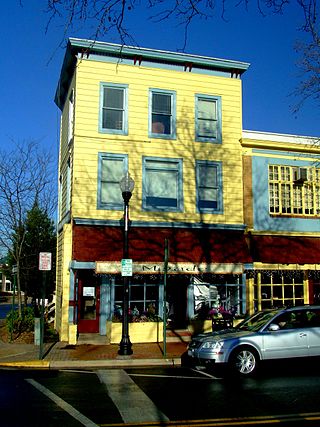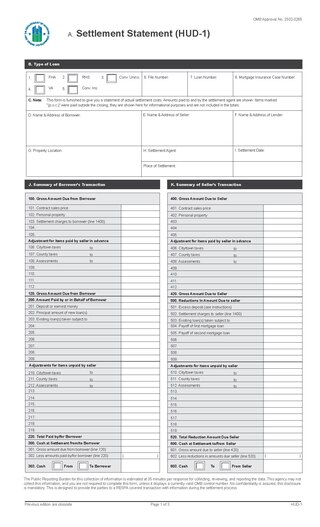Related Research Articles
In law, conveyancing is the transfer of legal title of real property from one person to another, or the granting of an encumbrance such as a mortgage or a lien. A typical conveyancing transaction has two major phases: the exchange of contracts and completion.
An escrow is a contractual arrangement in which a third party receives and disburses money or property for the primary transacting parties, with the disbursement dependent on conditions agreed to by the transacting parties. Examples include an account established by a broker for holding funds on behalf of the broker's principal or some other person until the consummation or termination of a transaction; or, a trust account held in the borrower's name to pay obligations such as property taxes and insurance premiums. The word derives from the Old French word escroue, meaning a scrap of paper or a scroll of parchment; this indicated the deed that a third party held until a transaction was completed.
A real estate agent, referred to often as a real estate broker, is a person who represents sellers or buyers of real estate or real property. While a broker may work independently, an agent usually works under a licensed broker to represent clients. Brokers and agents are licensed by the state to negotiate sales agreements and manage the documentation required for closing real estate transactions. Buyers and sellers are generally advised to consult a licensed real estate professional for a written definition of an individual state's laws of agency.
Title insurance is a form of indemnity insurance predominantly found in the United States and Canada which insures against financial loss from defects in title to real property and from the invalidity or unenforceability of mortgage loans. Unlike some land registration systems in countries outside the United States, US states' recorders of deeds generally do not guarantee indefeasible title to those recorded titles. Title insurance will defend against a lawsuit attacking the title or reimburse the insured for the actual monetary loss incurred up to the dollar amount of insurance provided by the policy.
Stamp duty is a tax that is levied on single property purchases or documents. A physical revenue stamp had to be attached to or impressed upon the document to show that stamp duty had been paid before the document was legally effective. More modern versions of the tax no longer require an actual stamp.
Real estate appraisal, property valuation or land valuation is the process of developing an opinion of value for real property. Real estate transactions often require appraisals because they occur infrequently and every property is unique, unlike corporate stocks, which are traded daily and are identical. The location also plays a key role in valuation. However, since property cannot change location, it is often the upgrades or improvements to the home that can change its value. Appraisal reports form the basis for mortgage loans, settling estates and divorces, taxation, and so on. Sometimes an appraisal report is used to establish a sale price for a property.

Real estate economics is the application of economic techniques to real estate markets. It tries to describe, explain, and predict patterns of prices, supply, and demand. The closely related field of housing economics is narrower in scope, concentrating on residential real estate markets, while the research on real estate trends focuses on the business and structural changes affecting the industry. Both draw on partial equilibrium analysis, urban economics, spatial economics, basic and extensive research, surveys, and finance.

The Truth in Lending Act (TILA) of 1968 is a United States federal law designed to promote the informed use of consumer credit, by requiring disclosures about its terms and cost to standardize the manner in which costs associated with borrowing are calculated and disclosed.
A good faith estimate, referred to as a GFE, was a standard form that had to be provided by a mortgage lender or broker in the United States to a consumer, as required by the Real Estate Settlement Procedures Act (RESPA). Since August 2015, GFE has been replaced by a loan estimate form, serving the same purpose but following slightly different guidelines set by CFPB, so as to reduce consumer confusion. A good faith estimate is a standard form intended to be used to compare different offers from different lenders or brokers. The estimate must include an itemized list of fees and costs associated with the loan and must be provided within 3 business days of applying for a loan. Since RESPA does not apply to Business Purpose Loans, no GFE is provided in those transactions.

A cadastre or cadaster is a comprehensive recording of the real estate or real property's metes-and-bounds of a country. Often it is represented graphically in a cadastral map.
Closing costs are fees paid at the closing of a real estate transaction. This point in time called the closing is when the title to the property is conveyed (transferred) to the buyer. Closing costs are incurred by either the buyer or the seller.

Commercial property, also called commercial real estate, investment property or income property, is real estate intended to generate a profit, either from capital gains or rental income. Commercial property includes office buildings, medical centers, hotels, malls, retail stores, multifamily housing buildings, farm land, warehouses, and garages. In many states, residential property containing more than a certain number of units qualifies as commercial property for borrowing and tax purposes.

The Real Estate Settlement Procedures Act (RESPA) was a law passed by the United States Congress in 1974 and codified as Title 12, Chapter 27 of the United States Code, 12 U.S.C. §§ 2601–2617. The main objective was to protect homeowners by assisting them in becoming better educated while shopping for real estate services, and eliminating kickbacks and referral fees which add unnecessary costs to settlement services. RESPA requires lenders and others involved in mortgage lending to provide borrowers with pertinent and timely disclosures regarding the nature and costs of a real estate settlement process. RESPA was also designed to prohibit potentially abusive practices such as kickbacks and referral fees, the practice of dual tracking, and imposes limitations on the use of escrow accounts.
Under Section 1031 of the United States Internal Revenue Code, a taxpayer may defer recognition of capital gains and related federal income tax liability on the exchange of certain types of property, a process known as a 1031 exchange. In 1979, this treatment was expanded by the courts to include non-simultaneous sale and purchase of real estate, a process sometimes called a Starker exchange.

A house price index (HPI) measures the price changes of residential housing as a percentage change from some specific start date. Methodologies commonly used to calculate an HPI are hedonic regression (HR), simple moving average (SMA), and repeat-sales regression (RSR).
Mortgage fraud refers to an intentional misstatement, misrepresentation, or omission of information relied upon by an underwriter or lender to fund, purchase, or insure a loan secured by real property.

A mortgage loan or simply mortgage, in civil law jurisdictions known also as a hypothec loan, is a loan used either by purchasers of real property to raise funds to buy real estate, or by existing property owners to raise funds for any purpose while putting a lien on the property being mortgaged. The loan is "secured" on the borrower's property through a process known as mortgage origination. This means that a legal mechanism is put into place which allows the lender to take possession and sell the secured property to pay off the loan in the event the borrower defaults on the loan or otherwise fails to abide by its terms. The word mortgage is derived from a Law French term used in Britain in the Middle Ages meaning "death pledge" and refers to the pledge ending (dying) when either the obligation is fulfilled or the property is taken through foreclosure. A mortgage can also be described as "a borrower giving consideration in the form of a collateral for a benefit (loan)".
A real estate transaction is the process whereby rights in a unit of property are transferred between two or more parties, e.g. in the case of conveyance one party being the seller(s) and the other being the buyer(s). It can often be quite complicated due to the complexity of the property rights being transferred, the amount of money being exchanged, and government regulations. Conventions and requirements also vary considerably among different countries of the world and smaller legal entities (jurisdictions).
A real estate derivative is a financial instrument whose value is based on the price of real estate. The core uses for real estate derivatives are: hedging positions, pre-investing assets and re-allocating a portfolio. The major products within real estate derivatives are: swaps, futures contracts, options and structured products. Each of these products can use a different real estate index. Further, each property type and region can be used as a reference point for any real estate derivative.

The HUD-1 Settlement Statement is a standardized mortgage lending form in use in the United States of America on which creditors or their closing agents itemize all charges imposed on buyers and sellers in consumer credit mortgage transactions. The HUD-1 is used primarily for reverse mortgages and mortgage refinance transactions. The reference to 'HUD' in the form's name refers to the Department of Housing and Urban Development.
References
- ↑ "Real estate": Oxford English Dictionary online: Retrieved September 18, 2011
- ↑ "Glossary of Terms". Real Estate Institute of Australia (REIA). Retrieved 25 March 2018.
- ↑ Annamoradnejad, Rahimberdi; Annamoradnejad, Issa; Safarrad, Taher; Habibi, Jafar (2019). "Using Web Mining in the Analysis of Housing Prices: A Case study of Tehran". 2019 5th International Conference on Web Research (ICWR). Tehran, Iran: IEEE. pp. 55–60. doi:10.1109/ICWR.2019.8765250. ISBN 9781728114316. S2CID 198146435.
- ↑ "Improving Competition in Real Estate Transactions, 2007". Oecd.org. Retrieved 3 January 2012.
- ↑ "Conveyancing Services Market, 2007". Europa (web portal). Retrieved 3 January 2012.
- ↑ "Modelling Real Property Transactions, 2001–2005". Cost.esf.org. Retrieved 3 January 2012.
- ↑ "Alistair A.R. Cockburn: Basic use case template". Alistair.cockburn.us. Retrieved 3 January 2012.
- ↑ Default. "WG Law and Modelling: UseCase descriptions of Subdivision Procedures, 2002". Costg9.plan.aau.dk. Retrieved 3 January 2012.
- ↑ "Ferlan, Sumrada and Mattsson: Modelling property transactions, pp. 27 – 79 in: Real Property Transactions. Procedures, Transaction Costs and Models. Edited by: J. Zevenbergen, A. Frank and E. Stubkjær". Iospress.nl. January 2008. Retrieved 3 January 2012.
- ↑ "Rados Sumrada: Modeling methodology for real estate transactions, 2005" . Retrieved 3 January 2012.
- ↑ "Hess and Vaskovich: Ontology Engineering for Comparing Property Transactions, pp. 183 – 201, and Hess and Schlieder: Ontology-Based Development of Reference Processes, pp. 203- 219, both in: Real Property Transactions. Procedures, Transaction Costs and Models. Edited by: J. Zevenbergen, A. Frank and E. Stubkjær". Iospress.nl. January 2008. Retrieved 3 January 2012.
- ↑ "Vitikainen: Transaction Costs Concerning Real Property – The Case of Finland, pp. 101 – 118 in: Real Property Transactions. Procedures, Transaction Costs and Models. Edited by: J. Zevenbergen, A. Frank and E. Stubkjær". Iospress.nl. January 2008. Retrieved 3 January 2012.
- ↑ "Stubkjær: Accounting Costs of Transactions in Real Estate – The Case of Denmark. Nordic Journal of Surveying and Real Estate Research, 2:1 (2005) 11–36". mts.fgi.fi. Archived from the original on 5 February 2009.
{{cite news}}: CS1 maint: unfit URL (link) - ↑ "Stubkjær, Lavrac and Gysting: Towards national real estate accounts: The case of Denmark and other European jurisdictions, pp. 119- 139 in: Real Property Transactions. Procedures, Transaction Costs and Models. Edited by: J. Zevenbergen, A. Frank and E. Stubkjær". Iospress.nl. January 2008. Retrieved 3 January 2012.
- ↑ "UN System of National Accounts 1993". mts.fgi.fi. Archived from the original on 13 August 2010.
- ↑ "Ejendomsregistrering i de nordiske lande" (PDF). Archived from the original (PDF) on 13 June 2007. Retrieved 17 February 2018.
- ↑ "Property formation in the Nordic countries – Denmark. National Survey and Cadastre (2008)" (PDF).